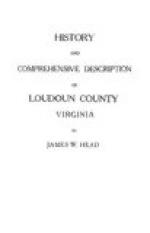[Footnote 35: The Confederate soldiers who fell in the battle of Ball’s Bluff are buried in Union Cemetery, on the northern border of Leesburg. Their resting place is marked by an imposing marble shaft, in honor of the comrades of “the lost cause,” “wherever they lie.” Many of the Union soldiers who perished at Ball’s Bluff lie buried where they fell. Their mournful little cemetery was recently acquired by the Federal government and its approaches and environs greatly improved. The battlefield is still one of the chief points of interest to visitors to central Loudoun.]
“Evans called on Longstreet for reinforcements when he reported his battle of the 21st, thinking that 20,000 Federals were in his front. Colonel Jenkins, with the Eighteenth South Carolina cavalry and artillery was dispatched from Centreville in the afternoon of the 22d, and marched toward Leesburg, through mud and a driving rain, until midnight, when the infantry went into bivouac; but Captain C.M. Blackford’s cavalry and four guns of the Washington artillery hurried forward all night and came in sight of Leesburg about daylight of the 23d. That morning, finding his men much exhausted, General Evans ordered three of his regiments to fall back to Carter’s mill, a strong position on Goose Creek, about 7 miles southwest from Leesburg, and join Jenkins, who had been halted at that place, leaving Barksdale with his regiment, two pieces of artillery and some cavalry, as a rear guard near Leesburg, and Hunton, with his Eighth Virginia and two pieces of artillery, on the south bank of Sycoline Creek, 3 miles from Leesburg, and sending his cavalry well to the front toward Alexandria.”
Munford’s Fight at Leesburg.[36]
“Having driven Pope’s army to a secure position behind the defences of Washington, General Lee turned northward to the Potomac and began the first Maryland campaign.
“While this movement was in progress Stuart covered the front toward Washington. He had learned that an irregular body of cavalry under a certain Captain Means was harassing the citizens in the vicinity of Leesburg, and on the 2d of September (1862) he sent Colonel Munford, with the Second Virginia Cavalry, to that point. On approaching Leesburg, Munford learned that it was occupied by Means’ company and that he was supported by about two hundred men under Major Cole, of Maryland. Munford’s regiment numbered only about one hundred and sixty men, but, approaching Leesburg by an unexpected direction, he effected a surprise, and after a heavy skirmish completely routed Means’ party and pursued him to Waterford, a distance of seven miles. He captured forty-seven prisoners, and killed or wounded twenty.”
[Footnote 36: Life and Campaigns of Maj.-Gen. J. E. B. Stuart.]
Battle at Aldie.[37]
“Early on the morning of the 17th of June, 1863, Colonel Munford, with the 2d and 3rd Virginia Cavalry, moved from Upperville through Middleburg, and having established his picket posts east of Aldie, crossed over to Snicker’s Gap road and proceeded with these two regiments to procure corn at the house of Franklin Carter, about a mile distant. He expected to encamp that night in the vicinity of Aldie.




